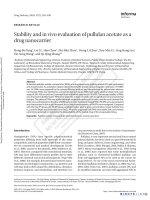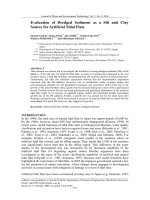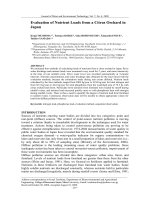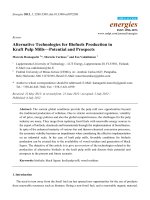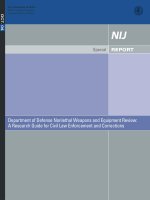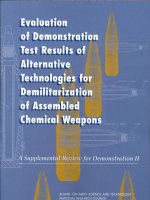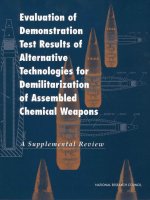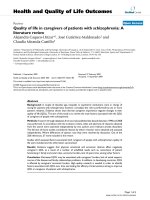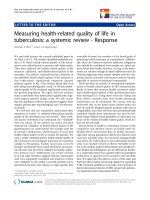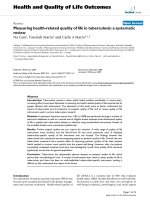Evaluation of Demonstration Test Results of Alternative Technologies for Demilitarization of Assembled Chemical Weapons A Supplemental Review for Demonstration II pptx
Bạn đang xem bản rút gọn của tài liệu. Xem và tải ngay bản đầy đủ của tài liệu tại đây (3.04 MB, 66 trang )
Evaluation of
Demonstration Test Results
of Alternative Technologies
for Demilitarization of
Assembled Chemical Weapons
A Supplemental Review for Demonstration II
Committee on Review and Evaluation of Alternative Technologies for
Demilitarization of Assembled Chemical Weapons: Phase II
Board on Army Science and Technology
Division on Engineering and Physical Sciences
National Research Council
NATIONAL ACADEMY PRESS
Washington, D.C.
NATIONAL ACADEMY PRESS • 2101 CONSTITUTION AVE, N.W. • WASHINGTON, DC 20055
NOTICE: The project that is the subject of this report was approved by the Governing Board of the National Research Council,
whose members are drawn from the councils of the National Academy of Sciences, the National Academy of Engineering, and
the Institute of Medicine. The members of the committee responsible for the report were chosen for their special competences
and with regard for appropriate balance.
This is a report of work supported by Contract DAAD19-00-C-0009 between the U.S. Army and the National Academy of
Sciences. Any opinions, findings, conclusions, or recommendations expressed in this publication are those of the author(s) and
do not necessarily reflect the views of the organizations or agencies that provided support for the project.
International Standard Book Number 0-309-07634-X
Limited copies are available from: Additional copies are available from:
Board on Army Science and Technology National Academy Press
National Research Council 2101 Constitution Avenue, N.W.
2101 Constitution Avenue, N.W. Lockbox 285
Washington, DC 20418 Washington, DC 20055
(202) 334-3118 (800) 624-6242 or (202) 334-3313
(in the Washington metropolitan area)
Copyright 2001 by the National Academy of Sciences. All rights reserved.
Printed in the United States of America
The National Academy of Sciences is a private, nonprofit, self-perpetuating society of distinguished scholars
engaged in scientific and engineering research, dedicated to the furtherance of science and technology and to their
use for the general welfare. Upon the authority of the charter granted to it by the Congress in 1863, the Academy
has a mandate that requires it to advise the federal government on scientific and technical matters. Dr. Bruce M.
Alberts is president of the National Academy of Sciences.
The National Academy of Engineering was established in 1964, under the charter of the National Academy of
Sciences, as a parallel organization of outstanding engineers. It is autonomous in its administration and in the
selection of its members, sharing with the National Academy of Sciences the responsibility for advising the federal
government. The National Academy of Engineering also sponsors engineering programs aimed at meeting national
needs, encourages education and research, and recognizes the superior achievements of engineers. Dr. Wm. A. Wulf
is president of the National Academy of Engineering.
The Institute of Medicine was established in 1970 by the National Academy of Sciences to secure the services of
eminent members of appropriate professions in the examination of policy matters pertaining to the health of the
public. The Institute acts under the responsibility given to the National Academy of Sciences by its congressional
charter to be an adviser to the federal government and, upon its own initiative, to identify issues of medical care,
research, and education. Dr. Kenneth I. Shine is president of the Institute of Medicine.
The National Research Council was organized by the National Academy of Sciences in 1916 to associate the
broad community of science and technology with the Academy’s purposes of furthering knowledge and advising
the federal government. Functioning in accordance with general policies determined by the Academy, the Council
has become the principal operating agency of both the National Academy of Sciences and the National Academy
of Engineering in providing services to the government, the public, and the scientific and engineering communi-
ties. The Council is administered jointly by both Academies and the Institute of Medicine. Dr. Bruce M. Alberts
and Dr. Wm. A. Wulf are chairman and vice chairman, respectively, of the National Research Council.
National Academy of Sciences
National Academy of Engineering
Institute of Medicine
National Research Council
iv
COMMITTEE ON REVIEW AND EVALUATION OF ALTERNATIVE TECHNOLOGIES FOR
DEMILITARIZATION OF ASSEMBLED CHEMICAL WEAPONS: PHASE II
ROBERT A. BEAUDET, Chair, University of Southern California, Los Angeles
RICHARD J. AYEN, Waste Management, Inc. (retired), Jamestown, Rhode Island
JOAN B. BERKOWITZ, Farkas Berkowitz and Company, Washington, D.C.
RUTH M. DOHERTY, Naval Surface Warfare Center, Indian Head, Maryland
WILLARD C. GEKLER, EQE International/PLG, Irvine, California
SHELDON E. ISAKOFF, E.I. du Pont de Nemours and Company (retired), Chadds Ford, Pennsylvania
HANK C. JENKINS-SMITH, University of New Mexico, Albuquerque
DAVID S. KOSSON, Vanderbilt University, Nashville, Tennessee
FREDERICK J. KRAMBECK, Mobil Technology Company, Paulsboro, New Jersey
JOHN A. MERSON, Sandia National Laboratories, Albuquerque, New Mexico
WILLIAM R. RHYNE, H&R Technical Associates, Inc., Oak Ridge, Tennessee
STANLEY I. SANDLER, University of Delaware, Newark
WILLIAM R. SEEKER, General Electric Energy and Environmental Research Corporation, Irvine, California
LEO WEITZMAN, LVW Associates, Inc., West Lafayette, Indiana
Board on Army Science and Technology Liaison
JOSEPH J. VERVIER, ENSCO, Inc., Indiatlantic, Florida
Staff
PATRICIA P. PAULETTE, Study Director
HARRISON T. PANNELLA, Program Officer
JAMES C. MYSKA, Research Associate
WILLIAM E. CAMPBELL, Administrative Coordinator
GWEN ROBY, Senior Project Assistant
v
BOARD ON ARMY SCIENCE AND TECHNOLOGY
WILLIAM H. FORSTER, Chair, Northrop Grumman Corporation, Baltimore, Maryland
JOHN E. MILLER, Vice Chair, Oracle Corporation, Reston, Virginia
ROBERT L. CATTOI, Rockwell International (retired), Dallas, Texas
RICHARD A. CONWAY, Union Carbide Corporation (retired), Charleston, West Virginia
GILBERT F. DECKER, Walt Disney Imagineering (retired), Glendale, California
PATRICK F. FLYNN, Cummins Engine Company, Inc. (retired), Columbus, Indiana
HENRY J. HATCH, Army, Chief of Engineers (retired), Oakton, Virginia
EDWARD J. HAUG, University of Iowa, Iowa City
GERALD J. IAFRATE, North Carolina State University, Raleigh
MIRIAM E. JOHN, Sandia National Laboratories, Livermore, California
DONALD R. KEITH, Cypress International (retired), Alexandria, Virginia
CLARENCE W. KITCHENS, IIT Research Institute, Alexandria, Virginia
KATHRYN V. LOGAN, Georgia Institute of Technology (professor emerita), Roswell
JOHN W. LYONS, Army Research Laboratory (retired), Ellicott City, Maryland
JOHN H. MOXLEY, Korn/Ferry International, Los Angeles, California
STEWART D. PERSONICK, Drexel University, Philadelphia, Pennsylvania
MILLARD F. ROSE, Radiance Technologies, Huntsville, Alabama
GEORGE T. SINGLEY III, Hicks and Associates, Inc., McLean, Virginia
CLARENCE G. THORNTON, Army Research Laboratory (retired), Colts Neck, New Jersey
JOHN D. VENABLES, Venables and Associates, Towson, Maryland
JOSEPH J. VERVIER, ENSCO, Inc., Indiatlantic, Florida
Staff
BRUCE A. BRAUN, Director
MICHAEL A. CLARKE, Associate Director
WILLIAM E. CAMPBELL, Administrative Coordinator
CHRIS JONES, Financial Associate
GWEN ROBY, Administrative Assistant
DEANNA P. SPARGER, Senior Project Assistant
DANIEL E. TALMAGE, JR., Research Associate
vii
Preface
The United States has been in the process of destroying
its chemical munitions for well over a decade. Initially, the
U.S. Army, guided by recommendations from the National
Research Council (NRC), decided to use incineration as its
destruction method at all sites. However, citizens in some
states with stockpile storage sites oppose incineration on the
grounds that the exact nature of the effluents escaping from
the stacks cannot be determined. The Army has continued to
pursue incineration at four of the eight storage sites in the
continental United States where that process seemed appro-
priate. Nevertheless, influenced by growing public opposi-
tion to incineration and the 1996 NRC report Review and
Evaluation of Alternative Chemical Disposal Technologies,
the Army has also been developing technologies based on
chemical hydrolysis for the remaining sites. These processes
will be used to destroy the VX nerve agent stored at Newport,
Indiana, and the mustard agent stored at Aberdeen, Mary-
land, both of which are stored only in bulk one-ton contain-
ers and not in assembled munitions.
In 1996, persuaded by public opposition in Lexington,
Kentucky, and Pueblo, Colorado, Congress enacted Public
Law 104-201, which instructed the U.S. Department of
Defense (DoD) to “conduct an assessment of the chemical
demilitarization program for destruction of assembled
chemical munitions and of the alternative demilitarization
technologies and processes (other than incineration) that
could be used for the destruction of the lethal chemical agents
that are associated with these munitions.” In response, the
Army established the program manager for the Assembled
Chemical Weapons Assessment (PMACWA). In Public Law
104-208, the PMACWA was required to “identify and
demonstrate not less than two alternatives to the baseline
incineration process for the demilitarization of assembled
1
The U.S. Department of Energy and the National Aeronautics and Space
Administration have both adopted this approach. For example, at the NASA
Jet Propulsion Laboratory, the Dialogue process will be used in developing
a Mars sample-return mission, which is scheduled for 2012.
chemical weapons.” During the first phase of the Assembled
Chemical Weapons Assessment (ACWA) program, seven
technologies were evaluated. Three of them proceeded to
demonstration testing (Demo I) and one was dropped com-
pletely. In August 1999, the PMACWA selected two of the
Demo I technologies as candidates for the destruction of the
assembled munitions weapons at Pueblo Chemical Depot.
The two packages, General Atomics Total Solution (GATS)
and Parsons/Honeywell (formerly Parsons-Allied Signal)
water hydrolysis of explosives and agent technology
(WHEAT), were advanced to the engineering design study
phase of the ACWA program.
The PMACWA has involved the citizen stakeholders in
every aspect of the program, including the procurement pro-
cess. The Keystone Center, a nonprofit organization, was
hired to facilitate public involvement through a process
known as the Dialogue, which has become a model for public
involvement in matters of public concern.
1
The Congress mandated that the Army coordinate with
the NRC during the ACWA program. In response, the NRC
established the Committee on Review and Evaluation of
Alternative Technologies for Demilitarization of Assembled
Chemical Weapons (ACW I committee) in 1997 to oversee
this program. The question before the committee was not
whether incineration was an adequate technology for
destroying assembled chemical weapons but whether other
chemical processes acceptable to the stakeholders could be
viii PREFACE
used. The second NRC committee (ACW II committee) was
established in the spring of 2000 to evaluate the two engi-
neering design studies for the destruction facilities at Pueblo,
Colorado, and Richmond, Kentucky, and to evaluate the
demonstration testing of the three technology packages that
had not been selected for those sites or for previous demon-
stration testing.
Although the PMACWA had no intention of demon-
strating these three technologies, Public Law 106-79 (2000)
mandated that the PMACWA “conduct evaluations of [the]
three additional alternative technologies under the ACWA
program.” Furthermore, the PMACWA was directed to “pro-
ceed under the same guidelines as contained in Public Law
104-208 and continue to use the Dialogue process and
Citizens’ Advisory Technical Team and their consultants.”
Accordingly, the PMACWA initiated a program commonly
referred to as Demo II to demonstrate the three technologies
(AEA SILVER II™, the Foster Wheeler/Eco Logic/
Kvaerner integrated demilitarization process, and Teledyne-
Commodore’s solvated electron process) that had not been
selected during the first phase. The ACW II committee was
asked to determine if and how the Demo II results affected
its commentary, findings, and recommendations and the
steps that were suggested for implementation in the ACW I
report. This report presents the committee’s evaluation of
the second set of demonstration tests.
I wish to gratefully acknowledge the hard work of
members of the ACW II committee, all of whom served as
volunteers and provided the expertise necessary to carry out
this enormous task. They gave relentlessly and unselfishly
of their time and effort throughout the study. Their areas of
expertise included chemical processing, biological remedia-
tion, environmental regulations and permitting, energetic
materials, and public acceptance. Committee members
attended plenary meetings, visited the technology providers’
headquarters and test sites, observed design-review sessions,
and studied the extensive literature, including engineering
charts and diagrams, provided by the technology providers.
On behalf of the committee, I would like to also express
appreciation for the extensive support of the Army ACWA
team and its interactions with stakeholders and the Dialogue,
particularly the group’s Citizens Advisory Technical Team,
whose members attended all open meetings of the commit-
tee and shared information and views with it. The committee
also appreciated the openness and cordiality of the represen-
tatives of the technology providers. They and the Army
provided early drafts of their test reports and other documen-
tation to facilitate the committee’s evaluation.
A study such as this requires extensive logistic support;
the committee is indebted to the NRC staff for their assis-
tance. I would particularly like to acknowledge the close
working relationship I had with the NRC study director,
Patricia Paulette. We worked as a team in leading this study.
We spoke on the phone daily and e-mailed each other inces-
santly. The efforts of William Campbell, who took extensive
notes and provided real-time report corrections at all our
meetings as well as suggestions on how to best organize the
report, were invaluable to the committee and to me. Gwen
Roby provided the logistic support that enabled us to con-
centrate on our task. I am also indebted to my colleagues in
the Chemistry Department at the University of Southern
California who willingly took over my teaching duties while
I traveled on behalf of this study.
Robert A. Beaudet, Chair
Committee on Review and Evaluation
of Alternative Technologies for
Demilitarization of Assembled
Chemical Weapons: Phase II
ix
Acknowledgments
This report has been reviewed in draft form by individuals
chosen for their diverse perspectives and technical expertise,
in accordance with procedures approved by the NRC’s
Report Review Committee. The purpose of this independent
review is to provide candid and critical comments that will
assist the institution in making its published report as sound
as possible and to ensure that the report meets institutional
standards for objectivity, evidence, and responsiveness to
the study charge. The review comments and draft manuscript
remain confidential to protect the integrity of the delibera-
tive process. We wish to thank the following individuals for
their review of this report:
Steven Konkel, Eastern Kentucky University
Richard Magee, New Jersey Institute of Technology
Walter May, Consultant
Ray McGuire, Consultant
Vernon Myers, Environmental Protection Agency
Headquarters
George Parshall, E.I. du Pont de Nemours (retired)
Robert Olson, Consultant
Donald Sadoway, Massachusetts Institute of Technology
Martin B. Sherwin, Chemical Engineer (retired)
William Tumas, Los Alamos National Laboratory
Although the reviewers listed above have provided
many constructive comments and suggestions, they were not
asked to endorse the conclusions or recommendations nor
did they see the final draft of the report before its release.
The review of this report was overseen by Royce Murray,
University of North Carolina, appointed by the National
Research Council. He was responsible for making certain
that an independent examination of this report was carried
out in accordance with institutional procedures and that all
review comments were carefully considered. Responsibility
for the final content of this report rests entirely with the
authoring committee and the institution.
xi
Contents
EXECUTIVE SUMMARY 1
1 INTRODUCTION 6
Background, 6
Role of the National Research Council, 8
Statement of Task, 8
Scope and Approach of This Study, 9
Organization of This Report, 9
2 AEA SILVER II™ TECHNOLOGY PROCESS 10
Description of the Systems, 10
2 kW SILVER II™ System, 10
12 kW SILVER II™ System, 10
Testing, 12
Agent Tests, 12
Energetics Tests, 13
Test Results, 13
Destruction and Removal Efficiency, 13
Materials of Construction, 15
Characteristics of Gaseous, Liquid, and Solid Process Streams, 15
Electrochemical Efficiency, 16
AEA Design Changes Based on Test Results, 17
Reevaluation of Steps Required for Implementation, 17
Review of the ACW I Committee’s Findings, 19
Supplemental Findings, 22
Supplemental Recommendations, 22
3 FOSTER WHEELER/ECO LOGIC/KVAERNER INTEGRATED 23
DEMILITARIZATION PROCESS
Transpiring-Wall Supercritical Water Oxidation Unit, 23
Other Observations, 25
Gas-Phase Chemical Reduction System, 26
Safety Concerns, 27
xii CONTENTS
Reevaluation of Steps Required for Implementation, 27
Overarching Comment, 27
Pilot-Scale Evaluation for Hydrolysis of Energetics, 28
Pilot-Scale Evaluation for SCWO, 28
Pilot-Scale Evaluation for GPCR™, 28
Reevaluation of Findings from ACW I Report, 28
Supplemental Findings, 30
Supplemental Recommendations, 30
4 TELEDYNE-COMMODORE SOLVATED ELECTRON TECHNOLOGY PROCESS 31
Ammonia Fluid Jet Cutting and Washout, 31
Shredding of Metal Parts and Dunnage, 32
SET™ Treatment of Shredded Metal Parts and Dunnage, 32
Reevaluation of Steps Required for Implementation, 33
Reevaluation of Findings from ACW I Report, 33
Supplemental Finding, 34
5 UPDATE OF GENERAL FINDINGS AND RECOMMENDATIONS 35
Review of Earlier Findings and Recommendations, 35
Supplemental General Findings, 37
Supplemental General Recommendations, 37
REFERENCES 39
APPENDIXES
A Site Visits and Meetings 43
B Biographical Sketches of Committee Members 47
xiii
List of Figures and Tables
FIGURES
2-1 AEA SILVER II™ total system solution, 11
2-2 Process flow diagram of the AEA 2 kW demilitarization process, 12
2-3 Process flow diagram of the AEA 12 kW demilitarization plant, 13
2-4 Revised process flow diagram of the AEA SILVER II™ demilitarization process, 18
3-1 Schematic diagram of the FW/EL/K demilitarization process, 24
4-1 Schematic diagram of the Teledyne-Commodore SET™ process, 32
TABLES
ES-1 Summary Evaluation of the Maturity of Demo II Unit Operations and Processes, 3
1-1 Description of the Seven Technology Packages That Passed DoD’s Initial Evaluation, 7
2-1 Destruction Efficiency in the 2 kW Test Unit, 14
2-2 Anolyte Coupon Weights Before and After Testing, 15
5-1 Summary Evaluation of the Maturity of Demo II Unit Operations and Processes, 38
xiv
ACWA Assembled Chemical Weapons Assessment (program)
ACW I Committee on Review and Evaluation of Alternative Technologies for Demilitarization of
Assembled Chemical Weapons
ACW II Committee on Review and Evaluation of Alternative Technologies for Demilitarization of
Assembled Chemical Weapons: Phase II
AEA AEA Technologies Corporation
Ag
2+
silver II ions
AgCl silver chloride
a-HAX solution containing potassium hydroxide and humic acid
BIF boiler and industrial furnace
CATOX catalytic oxidation
CEES chloroethyl ethyl sulfide
CEM continuous emission monitor
CO carbon monoxide
CO
2
carbon dioxide
Composition B an energetic material that contains (nominally) 59.5 percent RDX, 39.5 percent TNT, and 1.0
percent wax
CWC Chemical Weapons Convention
DAAMS depot area air monitoring system
Demo I Demonstration I (demonstration testing of three technologies selected for the first phase of
ACWA technology testing)
DMMP dimethyl methylphosphonate
DoD U.S. Department of Defense
DPE demilitarization protective ensemble
DRE destruction and removal efficiency
ECBC Edgewood Chemical and Biological Center
EDP engineering design package
EDS engineering design study
EPA Environmental Protection Agency
Acronyms, Chemical Symbols, and Abbreviations
ACRONYMS, CHEMICAL SYMBOLS, AND ABBREVIATIONS xv
FEK or FW/EL/K Foster Wheeler/Eco Logic/Kvaerner
GATS General Atomics Total Solution
GB a nerve agent
GC/MS gas chromatography/mass spectrometry
GPCR™ gas-phase chemical reduction
H
2
hydrogen
HD distilled mustard agent
HF hydrofluoric acid
HNO
3
nitric acid
HPLC high-performance liquid chromatography
HRA health risk assessment
ICI Imperial Chemical Industries
IMPA isopropyl methylphosphonic acid
IRS impurities removal system
KOH potassium hydroxide
LMIDS Lockheed Martin Integrated Demilitarization System
MACT maximum achievable control technology
MDM multipurpose demilitarization machine
MPA methylphosphonic acid
M28 energetic material used for propulsion of certain assembled chemical weapons
N
2
nitrogen
NO
x
nitrogen oxides
N
2
O nitrous oxide
NRC National Research Council
O
2
oxygen
PA picric acid
PCP pentachlorophenol
PGB product gas burner
PMACWA program manager for the Assembled Chemical Weapons Assessment
PMD projectile mortar demilitarization (machine)
POTW publicly owned treatment works
ppm parts per million
PTFE polytetrafluoroethylene (Teflon)
QRA quantitative risk assessment
RCRA Resource Conservation and Recovery Act
RDX cyclotrimethylenetrinitramine
RFP request for proposals
SCWO supercritical water oxidation
xvi ALTERNATIVE TECHNOLOGIES FOR DEMILITARIZATION OF ASSEMBLED CHEMICAL WEAPONS
SET™ solvated electron technology
SILVER II™ electrochemical oxidation using silver II ions in nitric acid
SO
x
sulfur oxides
SO
2
sulfur dioxide
SVOC semivolatile organic compound
TBA tributylamine
TC Teledyne-Commodore
TCLP toxicity characteristic leachate procedure
TNB trinitrobenzene
TNBA trinitrobenzoic acid
TNT trinitrotoluene, an energetic material
TOC total organic carbon
TRBP thermal reduction batch processor
TW-SCWO transpiring-wall supercritical water oxidation
VOC volatile organic compound
VX a nerve agent
WHEAT water hydrolysis of explosives and agent technology
3X At the 3X decontamination level, solids are decontaminated to the point that agent concentra-
tion in the headspace above the encapsulated solid does not exceed the health-based,
eight-hour, time-weighted average limit for worker exposure. The level for mustard agent
is 3.0 mg per cubic meter in air. Materials classified as 3X may be handled by qualified
plant workers using appropriate procedures but are not releasable to the environment or
for general public reuse. In specific cases in which approval has been granted, a 3X
material may be shipped to an approved hazardous waste treatment facility for disposal in
a landfill or for further treatment.
5X level Treatment of solids to a 5X decontamination level is accomplished by holding a material at
1,000°F for 15 minutes. This treatment results in completely decontaminated material
that can be released for general use or sold (e.g., as scrap metal) to the general public in
accordance with applicable federal, state, and local regulations.
5X treatment unit This unit is used to heat chemical solid waste materials to a level of decontamination where no
residual contamination is detectable.
1
Executive Summary
By direction of Congress, the U.S. Department of
Defense’s (DoD’s) program manager for the Assembled
Chemical Weapons Assessment (PMACWA) asked the Na-
tional Research Council (NRC) Committee on Review and
Evaluation of Alternative Technologies for Demilitarization
of Assembled Chemical Weapons: Phase II (the ACW II
committee) to conduct an independent scientific and techni-
cal assessment of three alternative technologies (referred to
as Demo II) under consideration for the destruction of
assembled chemical weapons at U.S. chemical weapons
storage sites. The three technologies are AEA Technologies
Corporation’s (AEA’s) electrochemical oxidation process;
the transpiring-wall supercritical water oxidation and gas-
phase chemical reduction processes of Foster Wheeler/Eco
Logic/Kvaerner (FW/EL/K); and Teledyne-Commodore’s
solvated electron process. Each of these technologies repre-
sents an alternative to incineration for the complete destruc-
tion of chemical agents and associated energetic materials.
The demonstration tests were approved by the PMACWA
after an initial assessment of each technology. The results of
that initial assessment were reviewed by an earlier NRC
committee, the Committee on Review and Evaluation of
Alternative Technologies for Demilitarization of Assembled
Chemical Weapons (the ACW I committee) (NRC, 1999).
For the present review, the committee conducted an in-
depth examination of each technology provider’s data, analy-
ses, and demonstration test results for the critical compo-
nents tested. This review report supplements the ACW I
report and considers the demonstration performance of the
Demo II candidate technologies and their readiness for ad-
vancement to pilot-scale implementation. Because testing in
these areas is ongoing, the committee decided to cut short its
fact-finding efforts for input to this report as of March 30,
2001. This cutoff was necessary in order to provide the
sponsor with the needed information in a timely fashion.
In 1996 the U.S. Congress enacted two laws, Public Law
104-201 (authorization legislation) and Public Law 104-208
(appropriation legislation), mandating that DoD assess alter-
native technologies to the baseline incineration process for
the demilitarization of assembled chemical munitions. In
December 1996 the deputy to the commander of the Soldier
Biological Chemical Command was appointed as the
PMACWA. Subsequently, seven technologies designed for
the complete destruction of assembled chemical weapons
were evaluated (ACW I report), and on July 29, 1998, three
of them were selected for the Demonstration I (Demo I)
phase of the ACWA program.
The PMACWA requested that the NRC perform an in-
dependent evaluation of the seven technology packages that
had been selected originally during earlier phases of the As-
sembled Chemical Weapons Assessment (ACWA) program
and deliver a report by September 1, 1999. However, to meet
that deadline, the NRC ACW I committee had to terminate
its data-gathering activities on March 15, 1999, before the
demonstration tests had been completed (NRC, 1999).
In September 1999, the PMACWA asked the ACW I
committee to examine the results of tests demonstrating the
operations of three of the original seven alternative tech-
nologies and to determine if they had changed the
committee’s original findings, recommendations, and com-
ments. Accordingly, the NRC published a supplemental re-
port in March 2000 (NRC, 2000), at which time the ACW I
committee was disbanded.
In 1999, Congress passed Public Law 105-261, mandat-
ing as follows:
The program manager for the Assembled Chemical Weap-
ons Assessment shall continue to manage the development
and testing (including demonstration and pilot-scale testing)
of technologies for the destruction of lethal chemical muni-
tions that are potential or demonstrated alternatives to the
baseline incineration program. In performing such manage-
ment, the program manager shall act independently of the
program manager for Chemical Demilitarization and shall
report to the Under Secretary of Defense for Acquisition and
Technology.
2 ALTERNATIVE TECHNOLOGIES FOR DEMILITARIZATION OF ASSEMBLED CHEMICAL WEAPONS
The Army was also directed to continue its coordination with
the NRC.
Congress extended the PMACWA’s task through Pub-
lic Law 106-79 by mandating that he “conduct evaluations
of [the] three additional alternative technologies under the
ACWA program, . . . proceed under the same guidelines as
contained in Public Law 104-208 and continue to use the
Dialogue process and Citizens’ Advisory Technical Team
and their consultants.” In response, the PMACWA initiated
a new test program, commonly referred to as Demo II, to
investigate whether three of the alternative technologies re-
maining from the original testing were ready to proceed to
an engineering design phase.
1
The remaining technologies
were from AEA, FW/EL/K, and Teledyne-Commodore. The
seventh of the original technologies had been judged to be
too immature for further testing during the original multi-
tiered selection process.
In response to Congress, a second NRC committee, the
Committee on Review and Evaluation of Alternative Tech-
nologies for Demilitarization of Assembled Chemical Weap-
ons: Phase II (ACW II committee), was formed and tasked
to produce three reports: (1) an evaluation of the Demo II
tests (Task 1), (2) an evaluation of two engineering design
studies (EDSs) and tests for use at the Pueblo, Colorado,
storage site (Task 2), and (3) an evaluation of EDS packages
and tests for the Blue Grass, Kentucky, site (Task 3).
The statement of task for Task 1 is as follows:
At the request of the DoD’s Program Manager for Assembled
Chemical Weapons Assessment (PMACWA), the NRC
Committee on Review and Evaluation of Alternative Tech-
nologies for Demilitarization of Assembled Chemical Weap-
ons will provide independent scientific and technical assess-
ment of the Assembled Chemical Weapons Assessment
(ACWA) program. This effort will be divided into three
tasks. In each case, the NRC was asked to perform a techni-
cal assessment that did not include programmatic (cost and
schedule) considerations.
Task 1
To accomplish the first task, the NRC will review and evalu-
ate the results of demonstrations for three alternative tech-
nologies for destruction of assembled chemical weapons lo-
cated at U.S. chemical weapons storage sites. The alterna-
tive technologies to undergo demonstration testing are: the
AEA Technologies electrochemical oxidation technology,
the Teledyne Commodore solvated electron technology, and
the Foster Wheeler and Eco Logic transpiring wall
supercritical water oxidation and gas phase chemical reduc-
tion technology. The demonstrations will be performed in
the June through September 2000 timeframe. Based on re-
ceipt of the appropriate information, including: (a) the
PMACWA-approved Demonstration Study Plans, (b) the
demonstration test reports produced by the ACWA technol-
ogy providers and the associated required responses of the
providers to questions from the PMACWA, and (c) the
PMACWA’s demonstration testing results database, the
committee will:
• Perform an in-depth review of the data, analyses, and
results of the unit operation demonstration tests contained in
the above and update as necessary the 1999 NRC report,
Review and Evaluation of Alternative Technologies for De-
militarization of Assembled Chemical Weapons (the ACW
report).
• Determine if any of the AEA Technologies, Teledyne
Commodore, and Foster Wheeler/Eco Logic technologies
have reached a technology readiness level sufficient to pro-
ceed with implementation of a pilot-scale program.
• Produce a report for delivery to the PMACWA by July
2001 provided the demonstration test reports are made avail-
able by November 2000. (An NRC report delivered in March
2000 covered the initial three technologies selected for dem-
onstration phase testing.)
In this current supplemental review, which responds to
Task 1, the ACW II committee provides an extensive review
of the data, analyses, and demonstration test results for criti-
cal components of the demilitarization processes of AEA,
FW/EL/K, and Teledyne-Commodore. Like the first supple-
mental review (NRC, 2000), this review evaluates the ef-
fects of the new test results on the findings and recommen-
dations in the original ACW I committee report (NRC, 1999)
and assesses the level of maturity attained by each technol-
ogy for proceeding to the engineering design phase of devel-
opment. A separate chapter is devoted to each technology,
and the chapters are organized as follows: descriptions of the
demonstrated unit operations; descriptions of the tests used
in the study, including committee commentary; a discussion
of the effects of the demonstration results on previous find-
ings; and, finally, new findings derived from this supple-
mental review. Chapter 5 considers the earlier general find-
ings and recommendations and presents new ones in light of
the demonstration test results.
In general, very few of the original findings and recom-
mendations were changed as a result of the new tests. In
some cases, the original findings and recommendations were
confirmed. The new findings and recommendations are pre-
sented below by technology. The level of development of
unit operation processes from the candidate technologies is
summarized in Table ES-1. General findings and recommen-
dations are also presented below.
1
The AEA, Eco Logic, and General Atomics technology packages
were chosen by the PMACWA to undergo engineering design studies
for the destruction of the assembled chemical weapons at the Blue Grass
Army depot. This decision was made by the PMACWA prior to the
issuance of this NRC report.
EXECUTIVE SUMMARY 3
SUPPLEMENTAL FINDINGS AND
RECOMMENDATIONS
AEA Demonstration Test
Finding DII AEA-1. The overall process flow has been fur-
ther complicated by major design changes in response to the
Demo II testing. These changes include the addition of the
impurities removal system (IRS), catalytic oxidation
(CATOX) units, and a flow return circuit from the catholyte
to the anolyte circuit. All three changes require small-scale
and pilot-scale testing. Such modifications further compli-
cate the interfaces between process units, which increases
the time required for development, start-up, and commis-
sioning of the full-scale system. Integration of the operating
units will make achievement of a viable total solution very
difficult.
Finding DII AEA-2. The discovery of organic material mi-
gration across the electrochemical cell membrane will re-
quire major modifications in design and operation, such as
recycling of the catholyte material to the anolyte circuit and
the addition of hydrocyclones in the catholyte circuit.
Finding DII AEA-3. The formation of intermediate oxida-
tion by-products raises operational issues, including slower
processing rates and reduced electrochemical efficiency.
During the testing with tetrytol in the 12 kW unit, the prob-
lems were severe enough to cause the runs to be extended
well beyond the planned processing times.
Finding DII AEA-4. The generation of new energetic com-
pounds trinitrobenzoic acid, picric acid, and trinitrobenzene
(TNBA, PA, and TNB) in the course of processing increases
the complexity and hazards of the SILVER II™ process. Al-
though the explosion hazard is reduced as the energetic feed
is consumed, it is not completely eliminated until all ener-
getic intermediates are destroyed.
Finding DII AEA-5. During the treatment of M28 in the
Demo II test, lead oxide and other materials accumulated on
cell anodes. The committee believes that a maintenance pro-
cedure for routine cleaning of the anodes will be required.
Finding DII AEA-6. Low steady-state electrochemical effi-
ciencies (20 to 30 percent) were observed during treatment
TABLE ES-1 Summary Evaluation of the Maturity of Demo II Unit Operations and Processes
Technology Provider/Unit
Hydrolysates Agent Munitions
Operation or Process VX/GB HD Energetics VX/GB HD Energetics Other
AEA
SILVER II™
a
CCC
Solid/liquid waste treatment C C C
Gaseous waste treatment D D D
Foster Wheeler/Eco Logic/Kvaerner
TW-SCWO B B C
GPCR™ BBB B
b,c
Teledyne-Commodore
Ammonia fluid jet cutting and D D E
washout system
SET™ DDD C
b
Persulfate oxidation (agent) D D D
Peroxide oxidation (energetics) D D D
Metals parts and dunnage A
b,c
shredding
NOTE: Environmental and safety issues were considered in assigning maturity categorizations. Schedule and cost issues were not considered. The letter
designations are defined as follows (a blank space indicates that categorization was not applicable for that material): A, demonstration provides sufficient
information to justify moving forward to full-scale design with reasonable probability of success; B, demonstration provides sufficient information to justify
moving forward to the pilot stage with reasonable probability of success; C, demonstration indicates that unit operation or process requires additional
refinement and additional demonstration before moving forward to pilot stage; D, not demonstrated, and more R&D is required; and E, demonstrated unit
operation or process is inappropriate for treatment.
a
Includes integrated gas polishing system to support demonstration.
b
Dunnage.
c
Metal parts.
4 ALTERNATIVE TECHNOLOGIES FOR DEMILITARIZATION OF ASSEMBLED CHEMICAL WEAPONS
of tetrytol. These low efficiencies will decrease the through-
put per cell and increase processing time and energy con-
sumption.
Finding DII AEA-7. Volatile organic compounds (VOCs)
were detected in the off-gas of the AEA process technology.
AEA has now included a CATOX unit in the preliminary
design. The committee believes that the introduction of this
additional unit operation will further complicate the scale-
up and integration.
Finding DII AEA-8. The IRS for removing salts (sulfates,
phosphates, silver fluoride), excess water, and any metals
that may be present requires extensive development and in-
tegration. The IRS has not yet been described in sufficient
detail to allow for a meaningful assessment.
Recommendation DII AEA-1. The possible formation of
lead picrate when mixed energetic feeds are treated must be
investigated before any processing of lead-containing pro-
pellant, TNT-based energetics, or tetryl is undertaken.
Recommendation DII AEA-2. The IRS, the CATOX units,
the return flow, and all other major modifications to the sys-
tem must be tested and proven during the EDS design phase.
Recommendation DII AEA-3. AEA must validate com-
plete destruction of all energetic intermediates during the
EDS design phase.
Recommendation DII AEA-4. AEA must conduct addi-
tional tests to identify suitable materials of construction to
overcome corrosion problems encountered owing to the for-
mation of hydrofluoric acid (HF) in the treatment of GB.
Foster Wheeler/Eco Logic/Kvaerner Demonstration Tests
Finding DII FEK-1. The proposed full-scale TW-SCWO
system has design and operating conditions significantly dif-
ferent from those tested in Demo II. These include the tem-
perature of the transpiration water at the inlet; pH of the
feed; turbulence in the reactor; and use of pure oxygen, not
air, as the oxidant.
Finding DII FEK-2. The proposed full-scale design for the
TW-SCWO system involves a scale-up in reactor cross-
sectional area by a factor of 2 from the Demo II test unit and
an increase in reactor throughput by a factor of 35. Perfor-
mance under these full-scale design conditions has not been
demonstrated.
Finding DII FEK-3. Aluminum present in the hydrolysates,
which could lead to the formation of slurries and plugging,
could be a problem. The proposed changes for mitigating
this problem (e.g., changing operating conditions and/or re-
moving aluminum during weapon disassembly) must be
tested.
Finding DII FEK-4. Demo II tests confirmed that firing
tubes and other solids could be treated to a 5X condition by
the GPCR™ process.
Finding DII FEK-5. All waste streams have been or can be
characterized sufficiently for engineering design to proceed.
Finding DII FEK-6. The current sampling and monitoring
systems for agent in gaseous streams have not been certified
or validated for use with the GPCR™ process off-gas.
Finding DII FEK-7. The product gas from the GPCR™ pro-
cess does not meet the EPA syngas requirements because of
high benzene and polyaromatic hydrocarbon content.
Finding DII FEK-8. While no agent was detected in the
scrubbing solutions and scrubber filters, the ability of the
GPCR™ process to destroy HD in mortars and neat GB
could not be confirmed because sampling and analysis prob-
lems hampered the gathering of gas-phase data.
Finding DII FEK-9. Little evidence of soot formation was
indicated when the GPCR™ unit was tested separately with
PCP-spiked wood, HD mortars, M55 rocket firing tubes, and
neat GB.
Finding DII FEK-10. The full-scale SCWO reactor design
has not been tested and is different in size and in the flow
rates of the feed streams from those used in the Demo II
tests. The full-scale design treats hydrolysate at a rate per
unit volume of reactor that is almost 10 times higher than
that used during the Demo II tests. In addition, the ratio of
the flow rates of all other streams to the flow rate of hydroly-
sate in the full-scale unit has decreased by approximately a
factor of 10 from those used during the Demo II tests. These
changes in hydrolysate processing per unit of reactor vol-
ume and the reduction of other feed streams relative to the
hydrolysate may reduce the efficacy of the SCWO reactor
and may be expected to exacerbate problems of corrosion
and plugging.
Finding DII FEK-11. The experience of multiple shutdowns
during Demo II testing of the TW-SCWO and the resulting
thermal stresses and crack generation in the liner indicate a
potential reliability issue, which must be significantly re-
duced or eliminated.
Recommendation DII FEK-1. Since the hydrolysate/total
feed ratio and flow velocity used in Demo II testing are so
different from those of the proposed design, the TW-SCWO
reactor must be tested at a hydrolysate/total feed ratio and
flow velocities close to the proposed design conditions.
EXECUTIVE SUMMARY 5
Recommendation DII FEK-2. Long-term testing of appro-
priately designed SCWO reactor liners under the new oper-
ating conditions for the proposed full-scale operation will be
necessary to prove the reliability and effectiveness of the
TW-SCWO unit.
Recommendation DII FEK-3. Long-term testing of the
TW-SCWO should include feeds containing chlorine, phos-
phorus, and sulfur and be at residence times and flow veloci-
ties close to the proposed design conditions.
Recommendation DII FEK-4. The Army or the technology
provider must develop analytical methods to determine the
quantities of agent in the gas streams containing hydrogen.
Teledyne-Commodore Demonstration Tests
Finding DII TC 1. Demo II tests were delayed and could
not be completed for the Teledyne-Commodore process be-
cause of incidents in which the immaturity of the process
became apparent. For example, an exothermic reaction be-
tween ammonia vapor and M28 propellant led to an ignition
incident. At another time, Composition B, dissolved in liquid
ammonia, leaked through flanges into valves and piping that
were intended to transfer the material from the ammonia
fluid jet-cutting vessel to the SET™ reactor. These inci-
dents revealed serious safety problems associated with the
Teledyne-Commodore process.
SUPPLEMENTAL GENERAL FINDINGS
General Finding DII 1. The demonstration tests were not
operated long enough to show reliability in long-term opera-
tion. The PMACWA’s Demo II tests were required to be of
the same duration as the Demo I tests. The technology pro-
viders had neither the time nor the resources for extensive
systemization (preoperational testing) in Demo II. Conse-
quently, these tests were simply proof-of-concept demon-
strations that indicate whether or not a particular unit opera-
tion (with more development) might be applicable to the
disposal of assembled chemical munitions.
General Finding DII 2. The AEA technology package is a
very complex, immature chemical processing system. Sev-
eral new unit operations required to address problems re-
vealed in the Demo II tests will significantly increase the
complexity of an integrated processing system and extend
the time required for its development.
General Finding DII 3. The demonstrated components of
the FW/EL/K technology package are ready to progress to
the EDS phase. However, certain key units were not tested
(or the results were inconclusive). Additional testing will be
needed to verify the ability of the transpiring-wall
technology to minimize corrosion; the testing should be
carried out in parallel with development of an engineering
design.
General Finding DII 4. Because of fire and safety prob-
lems, the basic process for the Teledyne-Commodore tech-
nology was not tested in Demo II. The Army decided against
going forward because the Demo II goals could not be met in
time. As a result, the committee had no technical basis on
which to evaluate the process any further.
General Finding DII 5. As was true for Demo I, none of the
unit operations tested in Demo II has been integrated into a
complete system. The lack of integration is a major concern
and a significant obstacle to full-scale implementation.
SUPPLEMENTAL GENERAL RECOMMENDATIONS
General Recommendation DII 1. Further development of
the Teledyne-Commodore technology package for the de-
struction of assembled chemical weapons should not be pur-
sued under the ACWA program.
General Recommendation DII 2. Before the AEA technol-
ogy proceeds to the EDS phase, extensive testing should be
performed on the SILVER II™ process, including all the
new unit operations that are being proposed to address the
shortcomings identified in Demo II results.
General Recommendation DII 3. For the FW/EL/K tech-
nology package, additional testing should be performed in
the EDS phase to complete GPCR™ off-gas characteriza-
tion and demonstrate long-term operation of the modified
TW-SWCO unit.
6
1
Introduction
BACKGROUND
In 1996 Congress enacted two laws, Public Law 104-
201 (authorization) and Public Law 104-208 (appropriation),
mandating that the U.S. Department of Defense (DoD) as-
sess technology alternatives for the baseline incineration pro-
cess for the demilitarization of assembled chemical weapons
and conduct demonstration tests of at least two of them. The
laws included the following stipulations:
• All funds for the construction of baseline incinera-
tion facilities at the Blue Grass Army Depot in
Richmond, Kentucky, and Pueblo Chemical Depot
in Pueblo, Colorado, should be frozen until the ef-
fectiveness of alternative technologies and their
ability to comply with safety and environmental
requirements were reported to Congress.
• DoD should select a program manager who was not
and had never been associated with the baseline in-
cineration program.
• DoD should “coordinate” its activities with the Na-
tional Research Council (NRC).
In December 1996, DoD appointed the deputy to the
commander of the Soldier and Biological Chemical Com-
mand to be the program manager for the Assembled Chemi-
cal Weapons Assessment (PMACWA). On July 28, 1997,
after organizing a staff and establishing a program plan, the
PMACWA published a request for proposals (RFP) for a
total system solution for the destruction of assembled chemi-
cal weapons without using incineration. Twelve proposals
were submitted in September 1997. Of these, seven passed
the threshold requirements stipulated in the RFP. These
seven technologies are summarized in Table 1-1. One of the
seven was rejected during the next phase of the selection
process. On July 29, 1998, after an elaborate multitiered
selection process, three of the remaining six technology
packages were selected for demonstration testing (Burns and
Roe, 1999; General Atomics, 1999; and Parsons-Allied Sig-
nal, 1999). Detailed descriptions of the selection process and
of all seven technologies are available in the PMACWA’s
two annual reports to Congress (DoD, 1997, 1998).
Under both time and budget constraints, the PMACWA
decided to focus the demonstration tests on the unit opera-
tions in each technology package that were “most critical
and least proven,” that is, operations that had not been previ-
ously used in the disposal of chemical munitions and/or had
not been integrated into a complete system for this applica-
tion. Systemization (preoperational testing) for the unit op-
erations to be tested was conducted from January to March
1999. The demonstration tests were conducted from March
to May 1999. On June 30, 1999, reports from the demonstra-
tion tests were submitted to the PMACWA by the technol-
ogy providers. These reports were used to prepare the
Supplemental Report to Congress that was submitted on Sep-
tember 30, 1999 (DoD, 1999). In 1999, Congress passed
Public Law 105-261 (1999) mandating that:
The program manager for the Assembled Chemical Weap-
ons Assessment shall continue to manage the development
and testing (including demonstration and pilot-scale testing)
of technologies for the destruction of lethal chemical muni-
tions that are potential or demonstrated alternatives to the
baseline incineration program. In performing such manage-
ment, the program manager shall act independently of the
program manager for Chemical Demilitarization and shall
report to the Under Secretary of Defense for Acquisition and
Technology.
It also directed the Army to continue coordination with
the NRC. In response, the PMACWA authorized engineer-
ing design studies for the two technologies that successfully
completed demonstration testing, the Parsons/Honeywell
technology package (hydrolysis followed by biotreatment)
and the General Atomics technology package (hydrolysis
followed by supercritical water oxidation (SCWO)). The
engineering design studies (EDSs) for both Parsons/
INTRODUCTION 7
Honeywell and General Atomics were configured for use at
the Pueblo Army Depot in Pueblo, Colorado (EDS I). How-
ever, only the engineering design study for General Atomics
(EDS II) will be considered for use at the Blue Grass Army
Depot in Richmond, Kentucky.
The purpose of the EDSs was to (1) support the certifi-
cation decision of the Under Secretary of Defense for Acqui-
sition and Technology, as directed by Public Law 105-261;
(2) support the development of an RFP for a pilot facility;
and (3) support the required documentation for the National
Environmental Policy Act and the Resource Conservation
and Recovery Act (RCRA) permit application. Each EDS
required an engineering design package (EDP) and tests to
generate data that had not been obtained during the demon-
stration test phase.
In 2000, Congress passed Public Law 106-79 mandat-
ing that the PMACWA
conduct evaluations of [the] three additional alternative tech-
nologies under the ACWA program, . . . proceed under the
same guidelines as contained in Public Law 104-208 and
TABLE 1-1 Description of the Seven Technology Packages That Passed DoD’s Initial Evaluation
Technology Access to Treatment of Treatment of Treatment of Treatment of
Provider
a
Munitions Agent Energetics Metal Parts Dunnage
AEA Modified reverse Electrochemical Treated with High-pressure acid Shredded and treated
assembly (high-pressure oxidation using silver SILVER II™ wash; thermal treatment with SILVER II™
wash, new rocket ions in nitric acid process. to 5X.
b
process.
shearing). (SILVER II™).
ARCTECH Modified reverse Hydrolysis with a-HAX Hydrolysis with Hydrolysis with a-HAX; Hydrolysis with dilute
assembly. (humic acid and strong a-HAX. shipped to Rock Island a-HAX; shipped to
base, KOH). Arsenal for 5X treatment. landfill.
Burns and Roe Modified reverse Plasma arc. Plasma arc. Melted in plasma arc. Shredded; processed in
assembly. plasma arc.
General Atomics Modified reverse Hydrolysis; supercritical Hydrolysis, SCWO. Hydrolysis; thermal Shredded; destroyed in
assembly; cryofracture water oxidation treatment to 5X. SCWO.
for projectiles. (SCWO).
Lockheed Martin Modified reverse Hydrolysis; SCWO; Eco Hydrolysis, SCWO, Hydrolysis; GPCR to Hydrolysis; GPCR to
(Foster/Eco assembly (multiple Logic gas-phase GPCR. 5X. 5X.
Logic/Kvaerner) lines, compact layout, chemical reduction
new drain and wash). (GPCR).
Parsons Modified reverse Hydrolysis; Hydrolysis, Thermal treatment to 5X. Thermal treatment to
assembly (fluid-jet biotreatment. biotreatment. 5X.
cutting and energetic
washout for rockets). .
Teledyne- Fluid-jet cutting; access Solvated electron Solvated electron Wash in solvated Crushed or shredded;
Commodore and drain agent; wash process in ammonia for process in ammonia electron solution; treated in solvated
out energetics with reduction; chemical for reduction; oxidation to 3X;
c
ship electron solution;
ammonia. oxidation with sodium chemical oxidation to Rock Island Arsenal shipped to landfill.
persulfate. with sodium for 5X treatment.
persulfate.
a
Allied Signal was purchased by the Honeywell Corporation. Therefore, Parsons-Allied Signal is referred to as Parsons/Honeywell in this report. Lockheed
Martin decided not to continue as technology provider for its process, so this technology development is continuing with Kvaerner John Brown as the
integrator. Foster Wheeler is developing the supercritical water oxidation (SCWO) unit and Eli Eco Logic International is developing the Gas-Phase Chemical
Reduction unit (GPCR™); all three were originally teamed with Lockheed Martin.
b
Treatment of solids to a 5X decontamination level is accomplished by holding a material at 1,000°F for 15 minutes. This treatment results in completely
decontaminated material that may be released for general use or sold (e.g., as scrap metal) to the general public in accordance with applicable federal, state,
and local regulations.
c
At the 3X decontamination level, solids are decontaminated to the point that agent concentration in the headspace above the encapsulated solid does not
exceed the health-based, 8-hour, time-weighted average limit for worker exposure. The level for mustard agent is 3.0 µg per cubic meter in air. Materials
classified as 3X may be handled by qualified plant workers using appropriate procedures but are not releasable to the environment or for general public reuse.
In specific cases in which approval has been granted, a 3X material may be shipped to an approved hazardous waste treatment facility for disposal in a landfill
or for further treatment.
8 ALTERNATIVE TECHNOLOGIES FOR DEMILITARIZATION OF ASSEMBLED CHEMICAL WEAPONS
continue to use the Dialogue process and Citizens’ Advisory
Technical Team and their consultants.
The PMACWA then initiated a program, commonly referred
to as Demo II, to demonstrate the three technologies that had
not been selected during the first phase. The Demo II tests
were performed between July and September 2000 by three
technology providers: (1) AEA Technologies, (2) Foster
Wheeler/Eco Logic/Kvaerner, and (3) Teledyne-Commo-
dore. Based on the test results, these technologies could be
considered for the destruction of the chemical weapons at
the Blue Grass Army Depot and would progress to the engi-
neering design phase.
1
ROLE OF THE NATIONAL RESEARCH COUNCIL
The PMACWA requested that the NRC independently
evaluate alternative technologies and submit a report by Sep-
tember 1, 1999, a month before the Army’s report to Con-
gress was due. After agreeing on a statement of task in March
1997, the NRC formed the Committee on Review and Evalu-
ation of Alternative Technologies for Demilitarization of
Assembled Chemical Weapons (the ACW I committee). The
study was officially begun on May 27, 1997. The committee
evaluated all seven technology packages that had passed the
threshold requirements stipulated in the first RFP. As per the
statement of task, the committee did not recommend a best
technology or compare any of the technologies with the
baseline incineration process in use at some storage sites.
Members of the committee visited the demonstration sites
prior to systemization of the unit operations in January 1999,
but data-gathering activities had to be terminated on March
15, 1999 (before the results of the demonstration tests had
been received), to produce a final report by September 1,
1999. The committee’s report was submitted for peer review
on May 1, 1999, and released to the sponsor and the public
on August 25, 1999 (NRC, 1999).
In September 1999, the PMACWA requested that the
tenure of the committee be extended to review the results of
the demonstration tests (Demo I). The committee was asked
to determine if and how the results affected its original find-
ings and recommendations, as well as the suggested steps
for implementation (NRC, 1999). In March 2000, the com-
mittee published a supplemental report (NRC, 2000) docu-
menting its review of the Demo I test results and the impact
of those results on the conclusions of the initial report (NRC,
1999). The committee completed its task at the end of March
2000 and was disbanded.
A second NRC committee, the Committee on Review
and Evaluation of Alternative Technologies for Demilitari-
zation of Assembled Chemical Weapons: Phase II (the
ACW II committee) was formed in the spring of 2000 and
asked to produce three reports: (1) an evaluation of the new
demonstration tests (Demo II) and their impact on the find-
ings and recommendations presented in the NRC’s ACW I
report (NRC, 1999); (2) an evaluation of the EDSs for Pueblo
(EDS I); and (3) an evaluation of the EDSs for Blue Grass
Depot (EDS II). This report is an evaluation of the Demo II
tests and responds to the first task.
In addition to evaluating the test results, the committee
was asked to update the findings for these technologies in
the ACW I committee’s original report (NRC, 1999).
STATEMENT OF TASK
The complete statement of task for the ACW II commit-
tee study is given below. The current supplemental review
addresses only Task 1.
At the request of the DoD’s Program Manager for Assembled
Chemical Weapons Assessment (PMACWA), the NRC
Committee on Review and Evaluation of Alternative Tech-
nologies for Demilitarization of Assembled Chemical Weap-
ons will provide independent scientific and technical assess-
ment of the Assembled Chemical Weapons Assessment
(ACWA) program. This effort will be divided into three
tasks. In each case, the NRC was asked to perform a techni-
cal assessment that did not include programmatic (cost and
schedule) considerations.
Task 1
To accomplish the first task, the NRC will review and evalu-
ate the results of demonstrations for three alternative tech-
nologies for destruction of assembled chemical weapons lo-
cated at U.S. chemical weapons storage sites. The alterna-
tive technologies to undergo demonstration testing are: the
AEA Technologies electrochemical oxidation technology,
the Teledyne Commodore solvated electron technology, and
the Foster Wheeler and Eco Logic transpiring wall
supercritical water oxidation and gas phase chemical reduc-
tion technology. The demonstrations will be performed in
the June through September 2000 timeframe. Based on re-
ceipt of the appropriate information, including: (a) the
PMACWA-approved Demonstration Study Plans, (b) the
demonstration test reports produced by the ACWA technol-
ogy providers and the associated required responses of the
providers to questions from the PMACWA, and (c) the
PMACWA’s demonstration testing results database, the
committee will:
• perform an in-depth review of the data, analyses, and
results of the unit operation demonstration tests contained in
the above and update as necessary the 1999 NRC report,
Review and Evaluation of Alternative Technologies for De-
militarization of Assembled Chemical Weapons (the ACW
report)
1
The AEA, Eco Logic, and General Atomics technology packages were
chosen by the PMACWA to undergo engineering design studies for the
destruction of the assembled chemical weapons at the Blue Grass Army
depot. This decision was made by the PMACWA prior to the issuance of
this NRC report.
